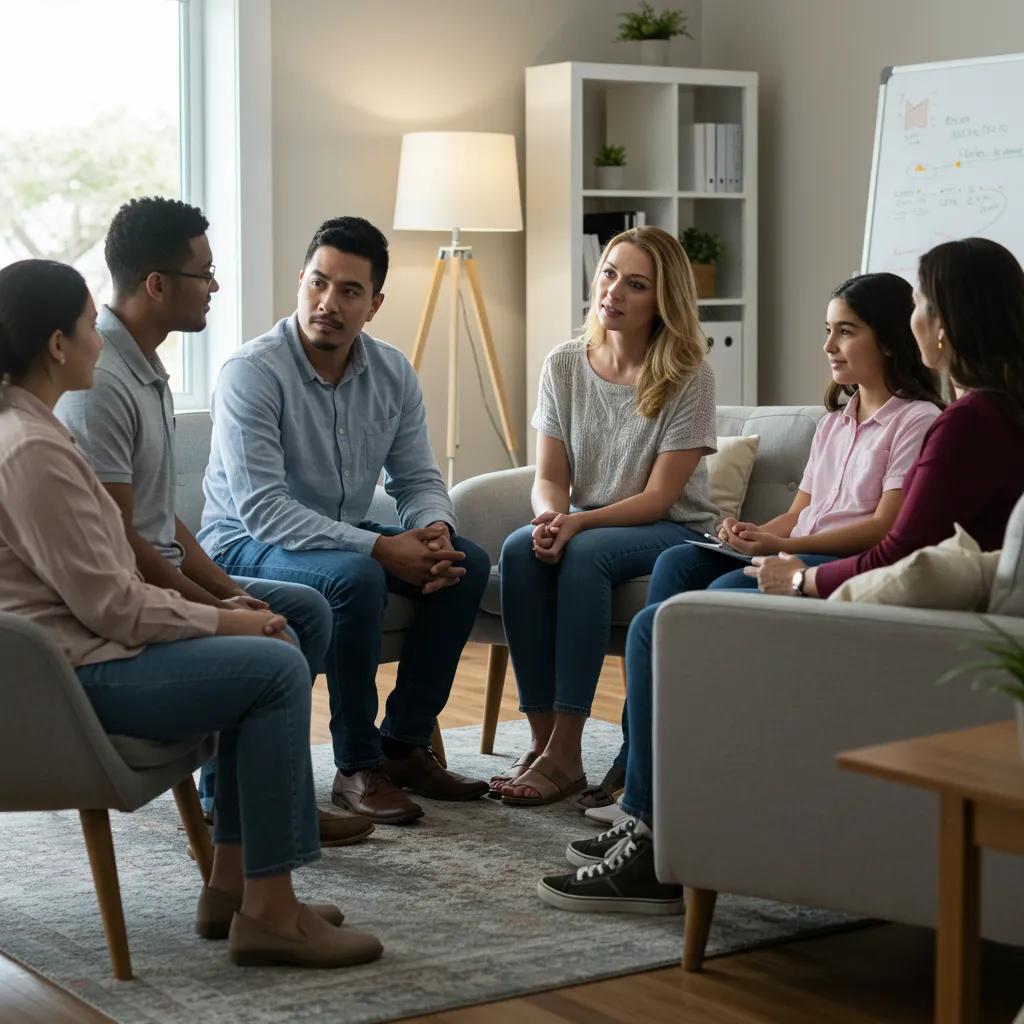Healing Together with Family Therapy: Benefits, Types, and Effective Techniques for Lasting Family Wellness
Family therapy brings family members into a structured therapeutic process that treats the family as an interactive system where patterns, roles, and communication shape individual and relational well-being. This article explains how family systems therapy works, why it accelerates recovery for conditions like addiction and adolescent mental health, and what families can expect from different models and residential programs. Many families struggle with repeated conflict, unclear roles, and barriers to supporting a member’s recovery; family therapy targets those dynamics directly and builds practical skills for sustained change. Below we map key benefits, summarize main therapy types (including structural, Bowenian, narrative, and systemic approaches), outline conflict-resolution techniques, and describe condition-specific applications and residential program features that can intensify progress.
What Are the Key Benefits of Family Counseling for Mental Health and Relationships?
Family counseling improves mental health and relationships by addressing interactional patterns that maintain symptoms, teaching communication skills that reduce escalation, and creating shared relapse-prevention strategies that support long-term recovery. Family therapists work by changing how family members respond, by clarifying roles and boundaries, and by coaching new, sustainable behaviors that replace dysfunctional cycles. The result is measurable: fewer repeated conflicts, clearer caregiving roles, and better adherence to treatment plans for individuals with mood, trauma-related, or substance-related conditions. The practical techniques that produce these outcomes set up the next section, which explains how communication and conflict resolution are improved in therapy.
Family therapy offers several core, research-backed benefits:
- Improved Communication: Therapy teaches structured listening and reflective speaking to reduce misunderstandings and build clarity.
- Conflict Reduction: Interventions target recurring patterns so arguments become less frequent and less intense.
- Support for Recovery: Families learn relapse-prevention skills that strengthen individual treatment gains.
- Strengthened Bonds: Psychoeducation and joint problem-solving increase cohesion and mutual support.
These benefits translate into daily routines and safety plans families can practice between sessions, which we explore next.
Different benefit areas operate through distinct mechanisms and produce predictable outcomes; the table below summarizes how key benefit domains map to mechanisms and expected results.
| Benefit Area | Mechanism | Expected Outcome |
|---|---|---|
| Communication | Structured dialogues, active listening | Clearer messages and fewer misunderstandings |
| Conflict Resolution | Enactments, problem-solving, boundary work | Reduced argument frequency and de-escalation |
| Recovery Support | Family-led relapse plans, psychoeducation | Lower relapse risk and improved treatment adherence |
| Bond Strengthening | Shared rituals, joint goals, reinforcement | Increased cohesion and mutual accountability |
How Does Family Therapy Improve Communication and Conflict Resolution?

Family therapy improves communication by training members in active listening, reflective statements, and time-limited check-ins that interrupt reactive cycles and create space for constructive responses. Therapists often use structured dialogues where one person speaks without interruption while others practice reflective statements, which reduces misinterpretation and emotional escalation. Role-plays and enactments let families practice new scripts in-session, making it easier to apply those scripts at home and gradually reduce argument frequency. Building these skills in-session leads directly into strategies for strengthening bonds and supporting recovery as family members practice consistent support.
In What Ways Does Family Therapy Strengthen Family Bonds and Support Recovery?
Family therapy strengthens bonds by aligning family members around shared psychoeducation, collaborative goal-setting, and concrete support roles that shift from blame to practical help. Psychoeducation demystifies diagnoses and reduces stigma within the household, which increases empathy and realistic expectations for recovery. Families participate in reintegration practices—such as negotiated responsibilities and reward structures—that help the recovering member re-enter daily life with supportive scaffolding. These approaches both reinforce individual treatment work and translate into measurable improvements in adherence and relapse prevention.
What Evidence Supports the Effectiveness of Family Counseling?
Current research indicates family-based interventions produce significant benefits across several conditions, with systematic reviews showing stronger outcomes for adolescent behavioral problems and for substance-use relapse prevention when family involvement is high. Randomized and quasi-experimental studies report improved treatment retention and lower relapse rates when families participate in structured treatment planning and skills training. Client-reported outcomes commonly highlight better communication and reduced conflict as early, durable gains, while clinical metrics document symptom reduction over months of coordinated care. Understanding this evidence base helps families choose approaches and set realistic milestones for progress.
What Are the Main Types of Family Therapy Used at Revival Mental Health?
Family therapy includes several evidence-based models—structural, Bowenian, narrative, and systemic approaches—that target different aspects of family functioning and are selected based on presenting dynamics and treatment goals. Each model defines change in a distinct way: structural therapy reshapes hierarchies and boundaries, Bowenian therapy examines multigenerational patterns, narrative therapy externalizes problems to re-author family stories, and systemic approaches map interactional cycles. In residential settings, these models are often integrated with skills-based therapies such as CBT and DBT to ensure both systems-level change and concrete behavioral tools. Below we summarize practical applications and when a clinician might choose each model in a residential program.
Family therapy modalities are commonly described as:
- Structural family therapy targets family organization and boundaries to create healthier hierarchies and clearer roles.
- Bowenian family therapy examines intergenerational patterns and promotes differentiation of self through genogram work.
- Narrative therapy externalizes problems and helps families re-author limiting stories into constructive narratives.
- Systemic therapy maps interactional cycles and uses circular questioning to reveal hidden feedback loops.
Selecting a modality depends on presenting problems and treatment goals; integration with CBT/DBT enhances skills coaching and emotional regulation across models.
The table below summarizes each therapy type, core attribute, and a typical use case for residential application.
| Therapy Type | Core Attribute | Typical Residential Use Case |
|---|---|---|
| Structural | Boundary and hierarchy work | Rebuilding parental leadership after role confusion |
| Bowenian | Genogram and multigenerational insight | Addressing inherited patterns tied to anxiety or substance use |
| Narrative | Externalization and re-authoring | Reducing shame and changing family narratives around behavior |
| Systemic | Interaction mapping and circular questioning | Identifying feedback loops maintaining conflict |
How Does Structural Family Therapy Address Family Dynamics?
Structural therapy defines problems as consequences of maladaptive family organization—blurred boundaries, diffuse authority, or enmeshed subsystems—and uses techniques like joining and enactment to restructure interactions. A therapist may “join” the family system to gain trust, then guide a live enactment where roles are clarified and alternative behaviors are rehearsed. Outcomes typically include clearer decision-making authority, consistent boundaries, and reduced triangulation that previously escalated conflicts. These practical shifts set the stage for more stable daily routines and improved parental leadership when appropriate.
The integration of art within structural family therapy can offer unique avenues for exploring and modifying family dynamics.
What Is Bowenian Family Therapy and Its Role in Healing?
Bowenian therapy focuses on multigenerational transmission of patterns and promotes differentiation of self so individuals act less reactively within relationships, reducing anxiety-driven reactivity across the system. Clinicians commonly use genograms to map relational patterns and identify repeating behaviors across generations, which fosters insight and deliberate change. Interventions emphasize reducing fusion and improving emotional regulation, enabling family members to hold separate perspectives without escalating conflict. This reflective work supports long-term resilience and lowers the likelihood that stressors will re-trigger old patterns.
Bowenian family systems theory provides a framework for understanding how intergenerational patterns, particularly those related to trauma and anxiety, can impact current family functioning.
How Are Narrative and Systemic Family Therapies Applied?
Narrative therapy helps families externalize problems—treating the issue as separate from the person—and co-create alternative, strengths-based stories that open up new options for behavior. Systemic therapy complements this by mapping interactional cycles and asking circular questions that reveal how each member contributes to sustaining problems. Together, these approaches shift blame to process and generate concrete experiments for new meanings and actions, such as new family rituals or shared scripts for conflict moments. Re-authoring narratives often reduces shame and empowers collaborative problem solving.
How Are CBT and DBT Techniques Integrated into Family Therapy?
CBT and DBT supply concrete skill modules—cognitive restructuring, behavioral activation, emotion regulation, and distress tolerance—that therapists adapt for multi-person work to change both thinking patterns and interactive habits. In family sessions, CBT techniques might target shared beliefs that maintain maladaptive responses, while DBT skills train families in validation, mindful presence, and crisis-safety behaviors. Practical activities include joint cognitive reframing exercises and in-session coaching for emotion regulation during heated interactions. Integrating these techniques ensures that systemic shifts are supported by evidence-based behavioral tools families can rehearse and apply outside therapy.
How Does Family Therapy Help Resolve Family Conflicts and Improve Communication?
Family therapy resolves conflict by teaching structured problem-solving, neutral facilitation to de-escalate attacks, and iterative practice that replaces reactive cycles with predictable, safe communication patterns. Therapists set ground rules for turn-taking and reflective listening, coach families through time-limited problem-solving steps, and assign between-session experiments to generalize new behaviors. The process emphasizes measurable skill rehearsal and modifications to the environment and routines that previously triggered conflict. These strategies naturally lead to boundary-setting guidance and crisis plan development that support safety and long-term stability.
Below are core conflict-resolution strategies used in therapy:
- Time-limited Check-ins: Scheduled short conversations that prevent escalation and allow focus on solutions.
- Structured Problem-Solving: Stepwise approach from defining the problem to testing small solutions.
- Neutral Facilitation: Therapist-guided enactments to practice new responses without blame.
- Behavioral Contracts: Written agreements that clarify expectations and follow-up steps.
After practicing these approaches in-session, families are better positioned to establish healthy boundaries and implement crisis plans at home.
What Are Effective Family Conflict Resolution Therapy Strategies?
Effective strategies include defining the problem behaviorally, using time-outs to reduce reactivity, and practicing stepwise solutions with accountability and follow-up. Therapists teach families to create precise, observable goals—what will change and how it will be measured—so progress is trackable. Role-play and enactments are used to rehearse the agreed-upon behaviors until they become automatic responses during stress. These tools reduce cycles of escalation and help families shift from blaming to collaborative problem-solving.
How Can Families Establish Healthy Boundaries Through Therapy?
Therapy assists families in clarifying roles, articulating age-appropriate expectations, and rehearsing scripts for enforcement that minimize power struggles. Practitioners recommend small behavioral experiments—such as a consistent morning routine or a single delegated responsibility—to test and reinforce boundaries. Families practice short, neutral scripts for enforcing rules and learn follow-up accountability measures that make enforcement predictable rather than punitive. Over time, consistent application of these strategies reduces conflict and improves daily functioning.
What Role Does Crisis Planning Play in Family Therapy?
Crisis planning provides a clear, rehearsed protocol for high-risk moments that identifies triggers, immediate coping steps, and designated contacts, which reduces chaos and improves safety. Therapists work with families to list specific warning signs, decide who does what when risk escalates, and create short-term containment strategies that prioritize de-escalation and help-seeking. Training focuses on predictable, simple actions—breathing techniques, safe time-outs, and referral steps—to avoid paralysis during crises. Having a plan increases confidence and reduces reactive patterns that can otherwise worsen outcomes.
Which Mental Health Conditions Benefit Most from Family Systems Therapy?
Family systems therapy benefits conditions where interactions or environmental patterns influence symptom maintenance, including addiction and co-occurring disorders, mood and anxiety disorders, trauma-related disorders, and adolescent behavioral health concerns. By addressing systemic contributors—such as enabling behaviors, accommodation of anxiety, or intergenerational trauma—family therapy transforms the social context that supports symptoms. Expected impacts include reduced relapse rates in substance use, better treatment adherence for depression and anxiety, and improved school and social functioning for adolescents. The table below maps common conditions to the role family therapy plays and typical impacts.
| Condition | Family-Therapy Role | Expected Impact |
|---|---|---|
| Addiction & co-occurring disorders | Education, relapse planning, family contracts | Lower relapse risk and improved coordination of care |
| Anxiety & depression | Reduce accommodation, increase activation | Improved mood and daily functioning |
| Trauma & PTSD | Stabilization, paced disclosure, safety planning | Safer processing and reduced retraumatization |
| Adolescent mental health | Boundary-setting, school coordination | Better engagement and behavioral regulation |
How Does Family Therapy Support Addiction and Co-Occurring Disorders?
Family therapy supports recovery by educating relatives about addiction dynamics, creating collaborative relapse-prevention plans, and addressing enabling behaviors that increase risk. Interventions include negotiated treatment contracts, monitoring triggers within the home environment, and building a supportive structure for aftercare. Family involvement improves adherence to medication and outpatient follow-up while reducing isolation that fuels relapse. When families practice these strategies intensively—especially in residential contexts—relapse probability declines and long-term recovery stabilizes.
What Is the Role of Family Therapy in Treating Anxiety and Depression?
Family therapy addresses family responses that inadvertently maintain anxiety and depression, such as excessive accommodation or avoidance, and replaces these with supportive activation and structured routines. Techniques include behavioral activation plans involving family members, communication scripts to express support without reinforcing avoidance, and joint problem-solving to reduce stressors. These interventions increase activity levels, reduce reinforcement of anxious behaviors, and create predictable supports that facilitate mood improvement. Family-based routines often accelerate outpatient gains.
How Does Family Therapy Address Trauma and PTSD Within Families?
Trauma-informed family therapy emphasizes stabilization, safety, and paced disclosure—protecting vulnerable family members from retraumatization while creating supportive processing contexts. Therapists focus first on emotion regulation and grounding skills for all members, then carefully coordinate if and how trauma narratives are shared within the family. Interventions prioritize consent, containment, and expert-led processing when appropriate, combining family support with individual trauma modalities as needed. Properly sequenced, this approach reduces secondary traumatization and strengthens collective recovery.
How Can Family Therapy Support Adolescent Mental Health Challenges?
Family therapy for adolescents targets developmental needs by improving parent-adolescent communication, calibrating boundaries to developmental stage, and coordinating supports with schools and outpatient providers. Practitioners use engagement strategies that validate adolescent autonomy while ensuring safety and consistent expectations. Family-based behavioral plans align home routines with therapeutic goals such as sleep, school attendance, and emotion regulation. Strong family coordination typically improves treatment adherence and reduces risky behaviors common in adolescence.
What Makes Residential Family Therapy at Revival Mental Health Unique?
Residential family therapy at Revival Mental Health combines immersive, 24/7 clinical support with a holistic integration of evidence-based modalities to create an environment where families can practice and consolidate skills continuously. This residential model allows therapists to observe and coach interactions in real time, translate skills learned in sessions into daily routines, and provide immediate crisis support when needed. Revival Mental Health’s Family Therapy program emphasizes personalized residential treatment plans, drawing on CBT, DBT, ACT, mindfulness, and creative modalities like art therapy to address diverse needs. The continuous clinical presence and tailored care accelerate skill acquisition and support safer transitions home.
Key differentiators in a residential model include:
- 24/7 Clinical Support: Continuous access to clinicians for coaching, safety, and real-time feedback.
- Holistic Modalities Integrated: Combining CBT/DBT with ACT, mindfulness, and expressive therapies for comprehensive care.
- Personalized Residential Plans: Tailored family goals, measurable milestones, and focused discharge planning.
How Does 24/7 Clinical Support Enhance Family Healing?
Around-the-clock clinical support enhances healing by offering immediate coaching during challenging interactions, rapid response in crises, and frequent opportunities to rehearse new behaviors outside formal sessions. Clinicians can model de-escalation, reinforce progress in the moment, and adjust interventions based on live observation rather than relying solely on retrospective reports. This continuity reduces risk, speeds consolidation of skills, and enables more precise measurement of change. Real-time support therefore shortens the learning curve and fosters confidence for families returning home.
What Holistic Therapeutic Modalities Are Included in Residential Family Therapy?
Residential family therapy draws on a spectrum of modalities—CBT and DBT for skills, ACT for values-based action, mindfulness for regulation, and art therapy for nonverbal expression—to meet diverse therapeutic needs within family work. CBT and DBT supply practical tools for thought restructuring and emotion regulation, while ACT helps families align behaviors with shared values. Mindfulness practices reduce reactivity during interactions, and art therapy offers alternative channels for processing difficult emotions and rebuilding connection. Integrating these modalities supports a personalized approach that addresses cognitive, emotional, and relational dimensions.
How Are Personalized Family Therapy Plans Developed and Implemented?
Personalized family plans begin with a structured intake assessment, collaborative goal-setting with measurable milestones, and a schedule that balances family sessions with individual and group modalities. Clinicians create clear, time-bound objectives and teach families specific skills to practice, while progress is monitored through regular reviews and adjustments. Discharge planning emphasizes translation of in-residence gains into home-based strategies and outpatient follow-up to maintain momentum. This stepwise approach ensures that the residential experience yields durable change and a safe transition back to daily life.
What Happens During a Family Therapy Session at Revival Mental Health?
A family therapy session at a residential facility typically includes an initial assessment, guided enactments to practice skills, and assigned between-session work to generalize learning—structured to promote rapid feedback and sustained change. Sessions are intentionally task-focused: assess the interactional pattern, teach a small number of skills, rehearse those skills in-session, and assign targeted practice at home or in the residential setting. Therapists coordinate across individual, group, and family modalities so that interventions reinforce each other. The following subsections describe the typical intake, common techniques, and long-term skill-building plans families can expect.
How Is the Initial Family Assessment Conducted?
The initial assessment collects family history, symptom patterns, a genogram to map relational patterns, and joint goal-setting that specifies roles and safety needs. Clinicians ask about previous treatment, current stressors, and specific incidents that illustrate recurring problems to ground later interventions. Safety evaluations identify immediate risks and inform crisis planning, while families receive a transparent outline of treatment milestones and expected session structure. Preparing contributions from each member enables a focused, collaborative start.
What Are Common Family Therapy Techniques Used in Sessions?
Common techniques include enactments (live role-play of conflict), reframing to shift perspectives, structured communication exercises, and skill coaching for problem-solving and emotion regulation. Enactments let therapists identify and modify dysfunctional patterns directly, while reframing reduces blame and opens alternative meanings. Skill coaching focuses on micro-behaviors—how to make a reflective statement or apply a time-out—that families can practice immediately. Combining these techniques promotes rapid behavioral change and greater relational stability.
How Do Families Build Skills for Long-Term Communication and Support?
Long-term skill building centers on short, daily practices, weekly check-ins, and a maintenance checklist that families use to sustain gains after discharge. Therapists provide practical homework—such as three-minute daily check-ins, a shared activity calendar, or a crisis-response script—that reinforces session learning. Scheduled follow-ups and outpatient coordination create accountability and allow gradual tapering of support while preserving safety. These maintenance strategies help families convert residential progress into durable, home-based routines.
What Are the Most Common Questions About Healing Together with Family Therapy?
Families commonly ask about likely benefits, available therapy types, effectiveness for conflict resolution, support for addiction recovery, and how to begin treatment at a residential program. Short, direct answers help set expectations and next steps so families can decide whether family therapy fits their goals. Below are concise responses to these frequent questions, followed by actionable steps to get started with a residential provider if appropriate.
What Are the Benefits of Family Therapy for My Family?
Family therapy provides clearer communication, practical conflict-management tools, and coordinated relapse-prevention strategies that reduce reactivity and increase support for individuals in treatment. It helps families develop shared language about diagnoses, align expectations, and create durable routines that support mental health and recovery. Early benefits often include reduced argument frequency and better daily functioning, while longer-term gains involve sustained treatment adherence and lower relapse risk. These changes improve quality of life and the family’s capacity to manage future stressors together.
What Types of Family Therapy Are Available at Revival Mental Health?
Revival Mental Health offers a combination of structural, Bowenian, narrative, and systemic family therapy approaches integrated with CBT, DBT, ACT, mindfulness, and art therapy within its residential model. These modalities are selected and combined according to each family’s dynamics and treatment goals, ensuring both systems-level change and practical skills training. The residential setting enables iterative, in-the-moment coaching and frequent skill rehearsal to reinforce therapeutic gains. This integrated menu supports personalized residential plans focused on sustained healing.
The foundational principles of Bowenian family systems theory offer a comprehensive lens through which to understand and address complex family dynamics.
How Effective Is Family Therapy for Resolving Family Conflicts?
Family therapy is generally effective at reducing conflict when families engage consistently and practice new skills between sessions; success depends on factors like engagement level, problem chronicity, and follow-up support. Research and clinical experience indicate higher effect sizes when families commit to structured interventions and when therapy is paired with monitoring and aftercare. Variability arises from severity of issues and the degree of family readiness to change, but measurable improvements in communication and conflict frequency are common when evidence-based strategies are applied. Understanding these drivers helps set realistic expectations.
How Can Family Therapy Support Addiction Recovery?
Family therapy supports addiction recovery through psychoeducation, relapse-prevention planning, negotiated treatment contracts, and environmental changes that reduce triggers and enable accountability. Families learn to implement monitoring strategies, contingency plans, and supportive routines that align with individual treatment goals. Collaboration between family sessions and individual addiction treatment increases adherence to medication and outpatient care while reducing isolation that contributes to relapse. These joint strategies strengthen the network supporting recovery.
How Do I Get Started with Family Therapy at Revival Mental Health?
To begin, families typically call the facility phone number for an intake conversation, complete an initial assessment to determine fit and goals, and schedule an initial family intake to map needs and safety planning; Revival Mental Health can be reached at (949) 373-3138 for inquiries and pre-admission information. The intake process clarifies treatment options, estimated timelines, and how family sessions will be integrated into a personalized residential plan. Families should prepare to share relevant history, current stressors, and immediate safety concerns to make the assessment efficient and effective. Early engagement with a provider helps set clear milestones and transition plans for return to home life.





